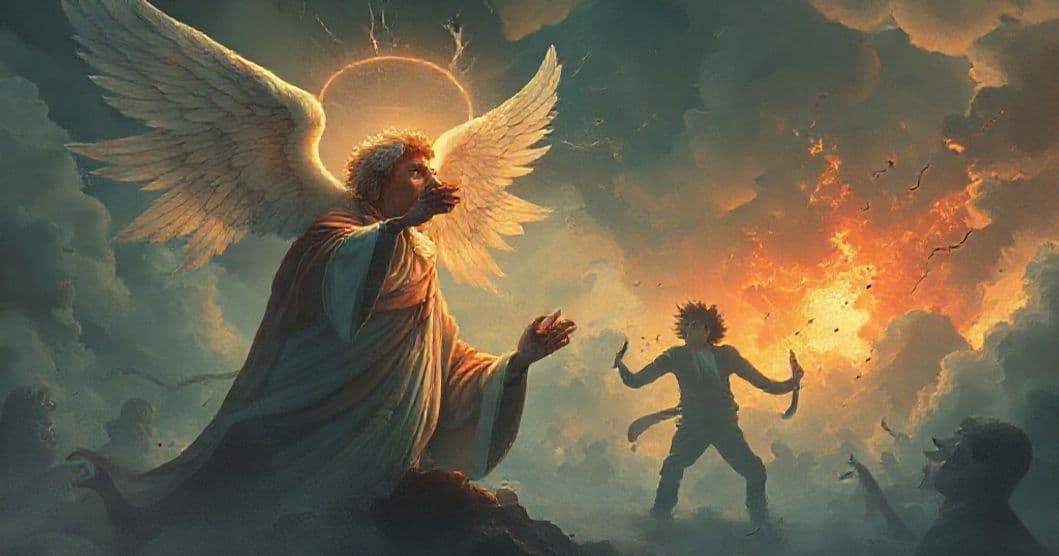The Angelic Preacher and the Rage of Youth: A Dream Analysis of Anger and Spiritual Disillusionment
Part 1: Dream Presentation
Dreams often preserve emotional truths from our past, even decades after they first appeared. This dream, recalled by a 24-year-old, offers a vivid snapshot of anger and spiritual conflict from his teenage years, unfolding in a medieval marketplace where an angelic figure’s preaching ignites a primal rage. The dreamer finds himself in a bustling square, surrounded by vendors shouting about their wares, while a crowd gathers around a man elevated on a wooden crate. This figure, tall with pale skin, medium-length blonde hair, and enormous white feathered wings, radiates a soft golden glow as he preaches about God’s salvation. The dreamer’s initial fascination shifts to overwhelming anger, prompting him to attack the figure with a brick, continuing his assault even after the figure falls. Most disturbingly, the crowd remains silent and passive, and the dreamer proceeds to bite and consume the figure’s body, awakening to nausea.
Part 2: Clinical Analysis
Symbolic Landscape of the Dream
Want a More Personalized Interpretation?
Get your own AI-powered dream analysis tailored specifically to your dream
🔮Try Dream Analysis FreeThe medieval marketplace serves as a powerful setting for this dream, evoking a time of collective activity and communal belief systems. In such spaces, authority figures—like the angelic preacher—held significant sway over public opinion and spiritual life. The preacher himself embodies multiple symbolic layers: his angelic wings represent spiritual guidance, purity, or divine protection, while his golden glow suggests an aura of holiness or enlightenment. However, the dreamer’s visceral rejection of this figure suggests a deeper conflict with traditional spiritual authority.
The crowd’s passivity is equally significant. Their silent observation implies societal indifference to the dreamer’s anger, or perhaps the dreamer’s perception that others are complicit in the spiritual system he resents. The brick, a common tool of both construction and destruction, symbolizes the dreamer’s attempt to dismantle the authority he finds oppressive. Most unsettling is the act of eating the preacher’s body—a powerful image that transcends literal violence. Eating can symbolize internalization of ideas, consumption of power, or a desperate attempt to make the 'divine' real by incorporating it into one’s own being.
Psychological Currents: Theoretical Frameworks
From a Jungian perspective, the angelic figure may represent the dreamer’s animus archetype—the masculine, spiritual aspect of the unconscious—or a projection of idealized authority. The preacher’s message of salvation could symbolize the dreamer’s longing for meaning, while his anger reflects the shadow aspect of his psyche—those repressed emotions he refuses to acknowledge. The shadow, in Jungian terms, is the part of ourselves we reject, and here it manifests as a violent, consuming rage.
Freudian theory might interpret the dream as a manifestation of repressed anger toward authority figures, possibly from religious upbringing or parental control. The teenage years are marked by identity formation, and the dream’s themes of rebellion against spiritual dogma could reflect the dreamer’s struggle to define his own beliefs separate from societal or familial expectations.
Neuroscientifically, dreams process emotional memories, particularly those tied to intense feelings. The dreamer’s age 14 was a period of hormonal and cognitive development, and the dream may represent unresolved emotions from that time. The physical nausea upon waking suggests the emotional intensity of the dream, even years later.
Emotional and Life Context
The dream likely emerged from the dreamer’s struggle with spiritual identity during adolescence. At 14, he may have been grappling with questions about faith, morality, and authority, particularly if raised in a religious household. The preacher’s message of 'forgiveness' and 'God’s graces' could have felt restrictive or judgmental, triggering anger at perceived hypocrisy or control.
The dream’s recurrence at age 24 suggests these unresolved emotions persist. As an adult, the dreamer may be re-evaluating his beliefs, facing new pressures, or experiencing renewed conflict with traditional authority structures. The violence in the dream reflects a deep-seated frustration with systems of power—whether religious, familial, or social—that he feels unable to challenge directly.
Therapeutic Insights
For the dreamer, this dream offers an opportunity to explore the roots of his anger toward spiritual or moral authority. Journaling exercises could help identify specific childhood experiences with religion or authority that sparked this rage. Reflective questions like 'What did I feel was being taken from me in that moment?' or 'How do I currently respond to systems I perceive as controlling?' might reveal patterns in his waking life.
Creative expression could channel this anger into productive outlets: painting, writing, or physical activities that allow him to process rage without harming others. Additionally, exploring his spiritual beliefs independently, without dogma, might help reconcile the conflict between his youthful rebellion and adult desire for meaning.
FAQ Section
Q: Why did the crowd remain silent in the dream?
A: The silent crowd may represent the dreamer’s perception of societal indifference to his anger or complicity in systems he rejects. It could also symbolize how he feels unseen or unheard in waking life.
Q: What does eating the angelic figure symbolize?
A: Eating the figure may represent internalizing the anger toward spiritual authority, consuming it to understand its source, or rejecting the 'divine' by making it part of himself.
Q: Why did this dream resurface at age 24?
A: Dreams revisit unresolved conflicts. At 24, the dreamer may face renewed spiritual questioning, triggering the teenage anger he buried but never resolved, manifesting in this visceral nightmare.
